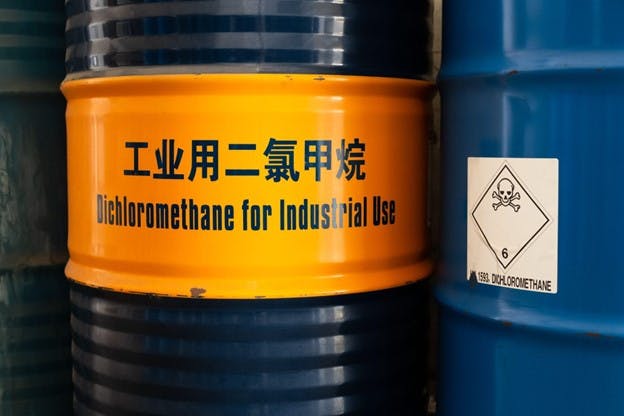April 2024
What Is Dichloromethane? Common Uses and Safety Concerns
From forever chemicals to pesticides, it’s natural to wonder what harmful chemicals are in our air and water. Methylene chloride, or dichloromethane (DCM), isn’t as well-known as some other dangerous substances, but this industrial solvent is a known carcinogen with some concerning effects on human health.
How likely is it to encounter dichloromethane in your daily life? Not very, unless you live or work in close proximity to particular industries. Still, dichloromethane can be found in some consumer products, since it’s only recently been phased out in the U.S.
Let’s take a look at what dichloromethane is, what it’s used for, and the health effects linked to exposure. Plus, we’ll look at how to protect yourself from dichloromethane if you work with it or suspect that your drinking water may be contaminated with it.
What Is Dichloromethane?
Dichloromethane is a colorless liquid that smells a bit like chloroform. It’s considered a volatile liquid, which means it can easily become a vapor or an aerosol. It has a boiling point of 103.3 degrees Fahrenheit and a melting point of -142.1 degrees Fahrenheit.
Dichloromethane has a chemical composition of CH2Cl2. It’s created by heating up chlorine and methane. It’s also known by the following synonyms:
- Methylene chloride
- Methylene bichloride
- Methylene dichloride
Dichloromethane has been used in everything from paint strippers and pharmaceuticals to adhesives and aerosol propellants. It can even be used to decaffeinate coffee beans! Although it has many uses, the U.S. Environmental Protection Agency (EPA) considers it an “unreasonable risk” to public health and has taken steps to restrict its use.
What Are the Potential Health Effects of Dichloromethane?
According to the American Council on Science and Health, people can be exposed to dichloromethane in one of three ways: skin contact, ingestion, and inhalation.
The health effects of dichloromethane vary depending upon the amount of exposure and the duration. Acute exposure to dichloromethane can lead to dizziness, fatigue, neurological symptoms, and in some cases, death.
Long-term exposure can have effects on the central nervous system and increase the risk of certain types of cancer. This is because dichloromethane is metabolized in the body in such a way that it produces formaldehyde, a known carcinogen.
The ACSH reports a link between “methylene chloride and brain cancer, liver cancer, and specific hematopoietic cancers, but not lung cancer.”
People who live or work near industrial sites or hazardous waste disposal sites are more likely to be exposed to dichloromethane than others.
What Is Dichloromethane Used For?
Dichloromethane is a solvent that’s primarily used for industrial purposes, such as paint stripping, metal cleaning, and degreasing. It works by breaking down the chemicals in paints and other coatings so they can be cleaned away more easily.
Dichloromethane may also be found in household paint removers and related products, but as of 2019, the EPA has banned its use in consumer products. In 2023, it followed up by banning them in many occupational settings as well.
Dichloromethane is also used in the production of pharmaceuticals, and can even be used to decaffeinate coffee beans. This isn’t considered a major source of exposure, however, because it’s easily removed following the decaffeination process.

How Much DCM Is Toxic?
The toxicity of dichloromethane depends on the type of exposure. Both inhalation and ingestion can cause irritation to mucous membranes, as well as nausea and vomiting, even in small amounts. At higher amounts, it can be fatal.
According to the EPA, there have been 85 fatalities caused by dichloromethane since 1980, mostly due to inhalation in poorly ventilated environments.
In Europe, the Scientific Committee on Occupational Exposure Limit Values (SCOEL) recommends a time-weighted average of 100 parts per million (ppm) over 8 hours, as well as a short-term exposure limit (STEL) of 200 per 15 minutes.
In the U.S., the Occupational Safety and Health Administration (OSHA.gov) and the National Institute for Occupational Safety and Health (CDC.gov/NIOSH) have set exposure limits of 25 ppm over 8 hours or 125 ppm over 15 minutes.
What Are Some Alternatives to Dichloromethane?
The University of Pennsylvania has a handy fact sheet on solvent alternatives to help people choose safer alternatives to toxic substances like dichloromethane.
Chloroform, carbon tetrachloride, and dichloromethane are all considered “undesirable” for use, while ethylene glycol and acetic acid are considered “usable.”
The “preferred” category includes less harmful substances such as acetone, ethanol, ethyl acetate, and methyl ethyl ketone.
How Can Workers and Individuals Protect Themselves When Working With Dichloromethane?
Although many companies are phasing out the use of dichloromethane to comply with new regulations, there’s still a risk of exposure in some occupational settings. It’s the employer's responsibility to monitor dichloromethane levels and ensure that proper ventilation measures are in place.
Most fatalities occur in poorly ventilated spaces, or in cases when the employee wasn’t wearing protective gear. Exposure can occur even outside of industrial settings — for example, while refinishing a bathtub in a private home.
Workers and individuals can protect themselves in four key ways:
- First, wear protective gear. Since dichloromethane can be absorbed through the skin, it’s important to cover the body fully, including the hands and feet. Use eye protection such as goggles or a face shield.
- Second, ensure proper ventilation, especially when working in enclosed spaces. This could take the form of a ventilation system or a personal respirator.
- Next, clean up any spills and dispose of materials properly. Label any containers with dichloromethane and follow your organization’s waste disposal guidelines.
- Finally, don’t eat or drink in areas where dichloromethane is used. Always wash your hands thoroughly before eating and change your clothes after work. Avoid alcohol since it can increase the effects of dichloromethane exposure.

What Happens When You Mix Dichloromethane With Water?
Dichloromethane and water don’t mix. If you pour them into a vessel together, they’ll remain separate, with dichloromethane on the bottom due to its higher density. DCM does have some solubility in water, but only about 20 grams per liter.
Water is a polar substance, and dichloromethane is only partially polar, meaning its atoms have slightly different charges compared to one another. Although it doesn’t interact with water, it can interact with amines, a type of ammonia derivative.
Dichloromethane has a high vapor pressure, so it evaporates quickly and emissions don’t tend to accumulate in the atmosphere. As the World Health Organization (WHO) explains, “Most dichloromethane released to water and soil will be vaporized. It can persist in air for up to 500 days, but is rapidly degraded in water.”
Does Drinking Water Contain Dichloromethane?
Dichloromethane isn’t a major contaminant of concern in drinking water, but some parts of the world may have higher dichloromethane levels than others. In the U.S., the EPA has set a Maximum Contaminant Level Goal of zero, reflecting that no amount of dichloromethane is considered “safe” in drinking water.
However, the Maximum Contaminant Level is 5 parts per billion (ppm), which is “the lowest level to which water systems can reasonably be required to remove this contaminant should it occur in drinking water” using available technology.
According to the Environmental Working Group, a nonprofit, 384 utilities in 39 states were found to have at least some levels of dichloromethane in 2017-2019. The good news is that four utilities in California were found to be above health guidelines, and only one was found to be above the legal limit.
What Steps Are Being Taken to Reduce Dichloromethane Levels?
The amount of dichloromethane being produced has declined significantly over the past several decades, and will decline further under the EPA’s new guidelines.
Exposure to dichloromethane through drinking water primarily occurs in industrial areas, since it degrades quickly when it’s released into the environment.
The EPA’s Toxic Release Inventory (TRI) Program tracks how much dichloromethane is released each year. It declined from more than 8 million pounds in 2003 to less than 4 million pounds in 2013, including land, air, and surface water disposal.
In addition to tracking how much dichloromethane is being released, the EPA provides case studies on how companies can replace DCM with less toxic solvents.
Can Water Filters Remove Dichloromethane?
Unless you live and work near a facility that uses dichloromethane, the risk of exposure to dichloromethane in your drinking water is low. Still, your drinking water may contain other chemicals and volatile organic compounds (VOCs) worth worrying about.
The Environmental Working Group recommends activated carbon filters for removing dichloromethane. These types of water filters can also remove:
- Pesticides
- Volatile organic compounds (VOCs)
- Some disinfection byproducts
- Some heavy metals
Activated carbon filters won’t remove:
- Viruses and bacteria
- Nitrates and nitrites
- Hard water minerals
- Fluoride
Reverse osmosis filters have a semi-permeable membrane that can remove viruses and bacteria, total dissolved solids, heavy metals, and other contaminants, and may also be effective at reducing the amount of dichloromethane in your drinking water.

Should You Worry About Dichloromethane Exposure?
Dichloromethane is a colorless liquid that’s used in many industrial products, including paint removers and paint strippers. Although the EPA has banned its use in consumer products, it could still be present in older household items. Products containing DCM should be stored at cool temperatures and disposed of properly.
If you work in a facility that uses dichloromethane, always wear protective clothing and only work in well-ventilated areas to avoid accidental inhalation.
Dichloromethane is unlikely to be present in your municipal drinking water, since utility companies are required to test for and report unsafe levels of DCM. You may be more at risk of exposure to industrial chemicals if you have a private water well.
Consider installing a water filter or testing your tap water for common contaminants by scheduling your free tap water test today.